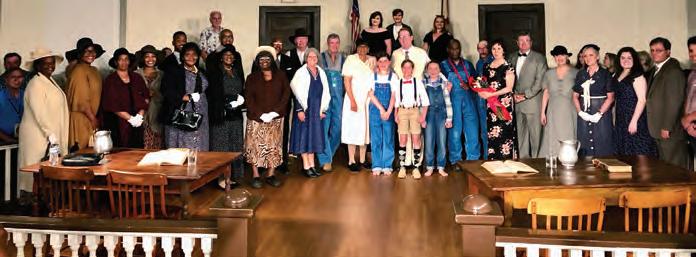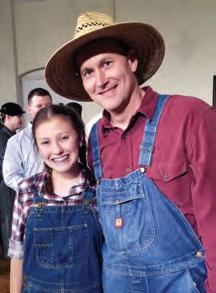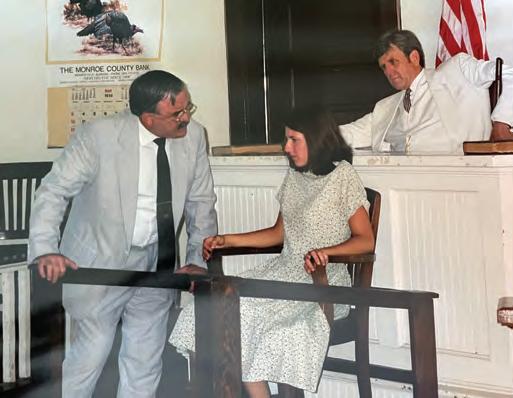
2 minute read
To Kill a Mockingbird
By Act
Two of “To Kill a Mockingbird,” text messages buzzed throughout Monroeville. “You will never guess who is here,” was a common post, as news spread. Seated in the audience was J.K. Rowling.
The author of the Harry Potter books was in town to enjoy the work of another famous author, Harper Lee. At the show’s end, Rowling vanished before most people knew she was there. But “To Kill a Mockingbird” remains and always will. Once you see it you never forget it.
One does not just “see” Monroeville’s play, one experiences it. “’ To Kill a Mockingbird’ is an immersive experience,” says play director Carly Jo Martens, who as a child played main character Jean Louise “Scout” Finch. “I’m not trying to toot our own horn, but Monroeville’s version is like no other.”
Kathy McCoy, the play’s first director, starting in 1991, adds, “It is a little bit magical, especially sitting in the Old Court House Museum where the story unfolds.”
The play starts outdoors in an amphitheater setting. In the second half, cast and audience enter the Old Courthouse Museum’s court room for the famous trial scene. Jury members are chosen from the audience and on with the show.
Carly notes the courtroom trial scene is difficult because it is uncomfortable. “Watching the trial you want to see justice,” she says. “You want to see Mayella Ewell testify, ‘This is not what happened!’ But she never does.”
“ To Kill a Mockingbird,” often required reading in middle school, has a dark side. Like the book, the play is a delicate balance of a child’s interaction with adult drama.
“When casting for Scout, I have a conversation with child applicants,” notes the director Martens. “For many children, the only acting experience they have is church plays which are usually sweet and happy. But ‘To Kill a Mockingbird’ is not sweet. It is bittersweet.”
Martens continues, “parents must know that Scout has a lot of lines. The actress portraying her needs to read the script daily.” Like “The Miracle Worker,” “To Kill a Mockingbird” depends on the crucial role of a child actress.

Kathy McCoy recalls the early days. “At first we were concerned how local people would react,” she notes, about the play’s initial performances. “Over the years the show became accepted. The town became an ambassador for the play.”
Monroeville’s performance is entirely volunteer area actors. “I did not want professionals,” McCoy recalls. “Part of the play’s charm is using amateur – but excellent – actors cast right here in Harper Lee’s hometown.”
The cast has also taken the show on the road, including Washington D.C., Chicago, Hong Kong, England, and Israel.
“I recall a performance in Jerusalem,” notes Monroeville’s Dot Bradley, who plays Calpurnia, the housekeeper. “During the show a guy in the audience keep wiping his eyes. After the performance, he came up to me, weeping, and said, ‘I’m sorry.’
“I told him, ‘Sir, don’t apologize for what you did not do. This play reminds us to respect yourself and respect others. So stop the tears.’ We hugged and he left.”
In 1962, Birmingham native Mary Badham played Scout in “To Kill a Mockingbird,” the movie. At age 10, with no previous acting experience, she was nominated for the Academy Award’s Best Supporting Actress.
But in that same evening, the Oscar went to another child actress, Patty Duke, for her performance as Helen Keller in “The Miracle Worker.”
Years later, both Patty Duke and Mary Badham attended the Alabama plays they became famous for. Thousands continue to do so.

Everyone interviewed for this story agrees, until you have seen these plays in the towns where they happened, you have not truly experienced them.
Yes, the rockets of Huntsville, the sea ports of Mobile, and industries of Birmingham, draw global recognition. But two small towns, Tuscumbia and Monroeville, put Alabama on the world’s stage.
Performances
“To Kill a Mockingbird,” April 14 – May 20.See website for specific dates and times. www.tokillamockingbird.com
For more stories and history,










